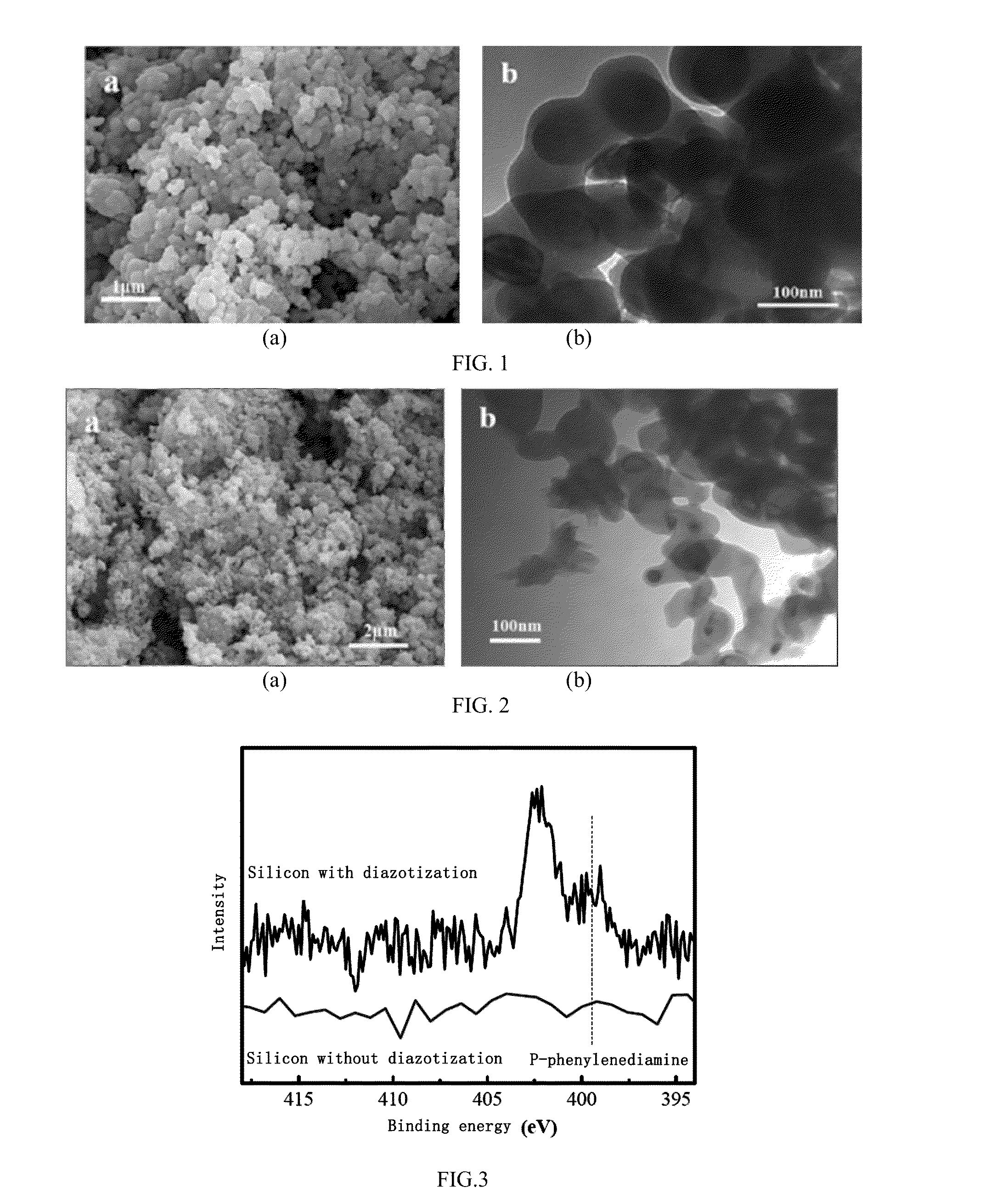Silicon based composite material, and preparation method and use thereof
a composite material and silicon technology, applied in the field of silicon based composite materials, can solve the problems of increasing energy density, poor cycle stability, and electrode active materials having higher specific energy, and achieves the effects of improving reducing polymerizing speed of phenylamine, and improving the hardness and binding energy of anode materials
- Summary
- Abstract
- Description
- Claims
- Application Information
AI Technical Summary
Benefits of technology
Problems solved by technology
Method used
Image
Examples
example 1
[0037]Preparation of a precursor:
[0038]20 g of p-phenylenediamine was added into 500 mL (1 mol / L) of hydrochloric acid (HCl) solution, and stirring was performed in a thermostat of 10° C. at a rotating speed of 150 rpm for 10 minutes;
[0039]100 mL (5.797 mol / L) of sodium nitrite (NaNO2) solution was dropped into the hydrochloric acid solution at a speed of 10 mL / min, and stirring was continuously performed at a rotating speed of 150 rpm for 10 minutes;
[0040]3.54 g of silicon nano-particle (D50, 40 nm) was added into the solution, stirring was performed at a rotating speed of 300 rpm for 10 minutes, filtering was performed under vacuum, and washing was performed with tetrahydrofuran and ethanol and then with deionized water to reach an oil-free state, followed by baking in a vacuum tank for 6 hours, to obtain 3.70 g of the precursor (in which the silicon nano-particles were linked with phenylamine monomers after diazotization reaction and substitution reaction);
[0041]Preparation of a ...
example 2
[0045]Preparation of a precursor:
[0046]10 g of p-phenylenediamine was added into 500 mL (1 mol / L) of sulfuric acid (H2SO4) solution, and stirring was performed in a thermostat of 10° C. at a rotating speed of 150 rpm for 10 minutes;
[0047]50 mL (5.797 mol / L) of sodium nitrite (NaNO2) solution was dropped into the sulfuric acid (H2SO4) solution at a speed of 10 mL / min, and stirring was continuously performed at a rotating speed of 150 rpm for 10 minutes;
[0048]3.54 g of the silicon nano-particle (D50, 100 nm) was added into the solution, stirring was performed at a rotating speed of 300 rpm for 10 minutes, filtering was performed under vacuum, and washing was performed with tetrahydrofuran and ethanol and then with deionized water to reach an oil-free state, followed by baking in a vacuum tank for 6 hours, to obtain 3.61 g of the precursor;
[0049]Preparation of a composite material:
[0050]20 mL of ethanol and 20 mL of deionized water were uniformly mixed, 90 mL of cyclohexane and 10 mL o...
example 3
[0053]Preparation of a precursor:
[0054]20 g of p-phenylenediamine was added into 500 mL (1 mol / L) of hydrochloric acid (HCl) solution, and stirring was performed in a thermostat of 10° C. at a rotating speed of 150 rpm for 10 minutes;
[0055]50 mL (5.797 mol / L) of sodium nitrite (NaNO2) solution was dropped into the hydrochloric acid (HCl) solution at a speed of 10 mL / min, and stirring was continuously performed at a rotating speed of 150 rpm for 10 minutes;
[0056]3.54 g of silicon nano-particle (D50, 10 nm) was added into the solution, stirring was performed at a rotating speed of 300 rpm for 10 minutes, filtering was performed under vacuum, and washing was performed with tetrahydrofuran and ethanol and then with deionized water to reach an oil-free state, followed by baking in a vacuum tank for 6 hours, to obtain 3.70 g of the precursor;
[0057]Preparation of a composite material:
[0058]20 mL of ethanol and 20 mL of deionized water were uniformly mixed, 90 mL of cyclohexane and 10 mL of...
PUM
| Property | Measurement | Unit |
|---|---|---|
| electric conductivity | aaaaa | aaaaa |
| particle size D50 | aaaaa | aaaaa |
| electric conductivity | aaaaa | aaaaa |
Abstract
Description
Claims
Application Information
 Login to View More
Login to View More - R&D
- Intellectual Property
- Life Sciences
- Materials
- Tech Scout
- Unparalleled Data Quality
- Higher Quality Content
- 60% Fewer Hallucinations
Browse by: Latest US Patents, China's latest patents, Technical Efficacy Thesaurus, Application Domain, Technology Topic, Popular Technical Reports.
© 2025 PatSnap. All rights reserved.Legal|Privacy policy|Modern Slavery Act Transparency Statement|Sitemap|About US| Contact US: help@patsnap.com



